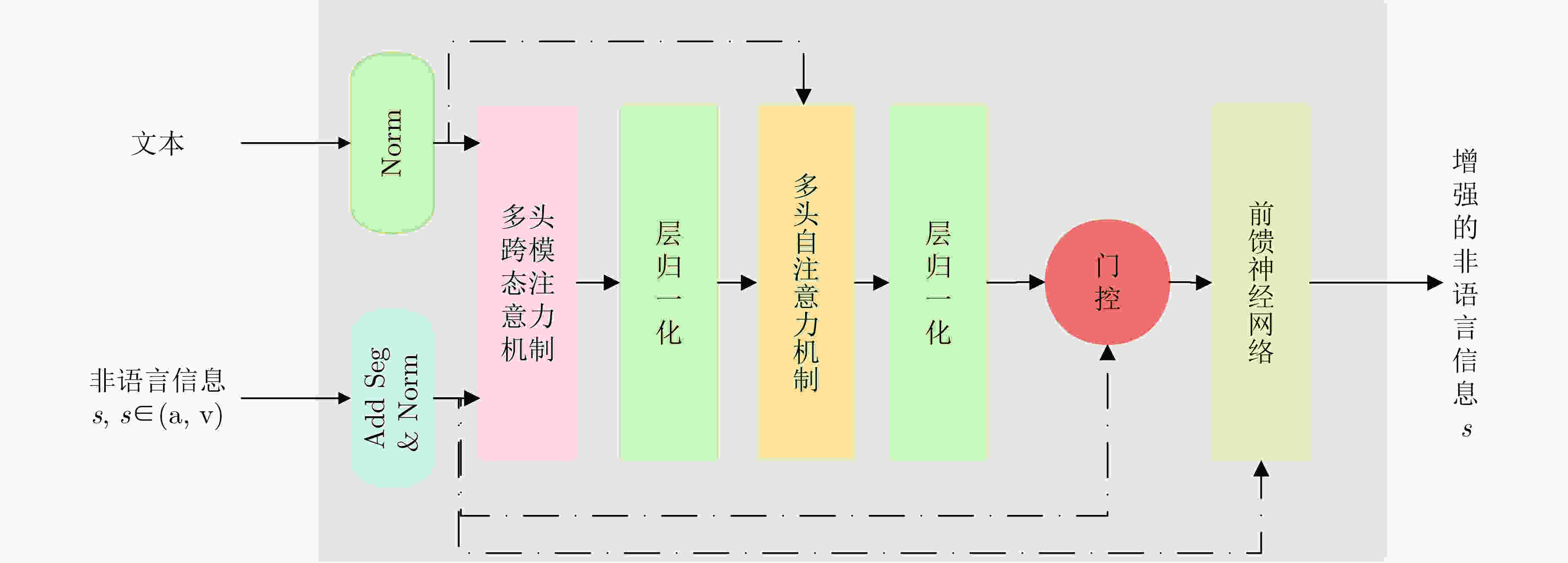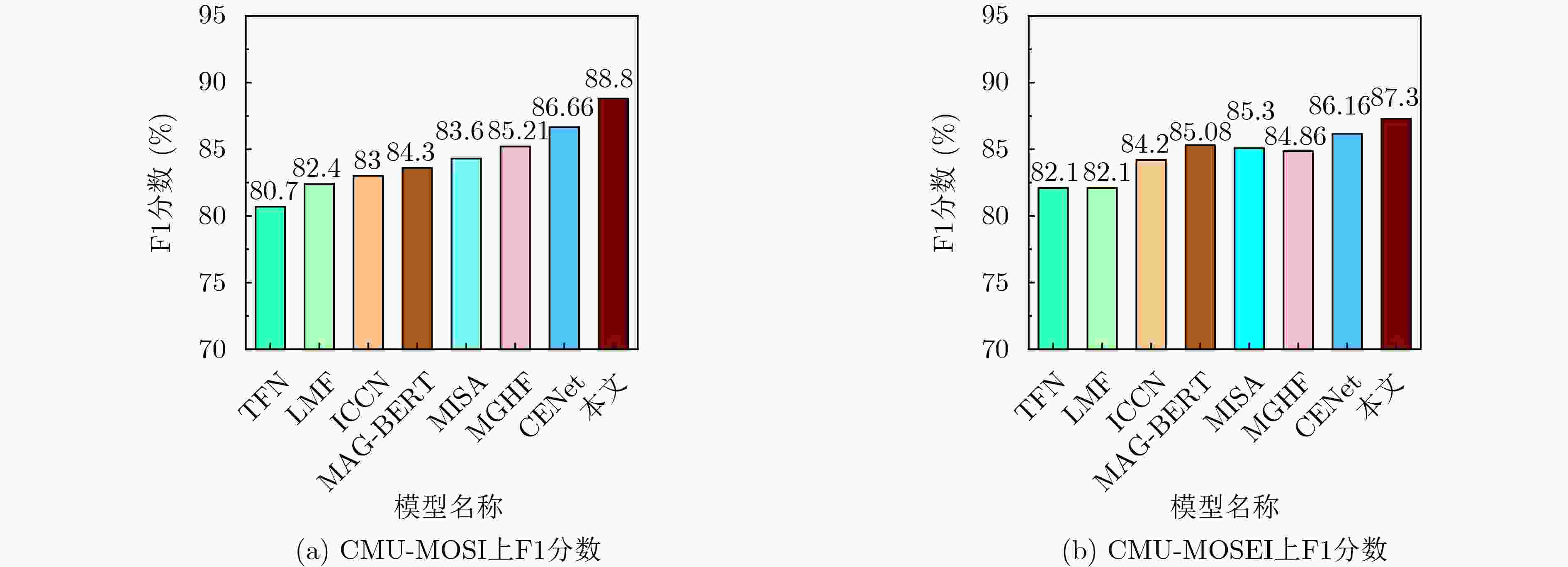A Multimodal Sentiment Analysis Model Enhanced with Non-verbal Information and Contrastive Learning
-
摘要: 因具有突出的表征和融合能力,深度学习方法近年来越来越多地被应用于多模态情感分析领域。已有的研究大多利用文字、面部表情、语音语调等多模态信息对人物的情绪进行分析,并主要使用复杂的融合方法。然而,现有模型在长时间序列中未充分考虑情感的动态变化,导致情感分析性能不佳。针对这一问题,该文提出非语言信息增强和对比学习的多模态情感分析网络模型。首先,使用长程文本信息去促使模型学习音频和视频在长时间序列中的动态变化,然后,通过门控机制消除模态间的冗余信息和语义歧义。最后,使用对比学习加强模态间的交互,提升模型的泛化性。实验结果表明,在数据集CMU-MOSI上,该模型将皮尔逊相关系数(Corr)和F1值分别提高了3.7%和2.1%;而在数据集CMU-MOSEI上,该模型将“Corr”和“F1值”分别提高了1.4%和1.1%。因此,该文提出的模型可以有效利用模态间的交互信息,并去除信息冗余。Abstract: Deep learning methods have gained popularity in multimodal sentiment analysis due to their impressive representation and fusion capabilities in recent years. Existing studies often analyze the emotions of individuals using multimodal information such as text, facial expressions, and speech intonation, primarily employing complex fusion methods. However, existing models inadequately consider the dynamic changes in emotions over long time sequences, resulting in suboptimal performance in sentiment analysis. In response to this issue, a Multimodal Sentiment Analysis Model Enhanced with Non-verbal Information and Contrastive Learning is proposed in this paper. Firstly, the paper employs long-term textual information to enable the model to learn dynamic changes in audio and video across extended time sequences. Subsequently, a gating mechanism is employed to eliminate redundant information and semantic ambiguity between modalities. Finally, contrastive learning is applied to strengthen the interaction between modalities, enhancing the model’s generalization. Experimental results demonstrate that on the CMU-MOSI dataset, the model improves the Pearson Correlation coefficient (Corr) and F1 score by 3.7% and 2.1%, respectively. On the CMU-MOSEI dataset, the model increases “Corr” and “F1 score” by 1.4% and 1.1%, respectively. Therefore, the proposed model effectively utilizes intermodal interaction information while eliminating information redundancy.
-
表 1 模型对比实验结果CMU-MOSI和CMU-MOSEI
模型 CMU-MOSI CMU-MOSEI MAE Corr Acc-7 Acc-2 F1 MAE Corr Acc-7 Acc-2 F1 TFN 0.901 0.698 34.90 80.80 80.70 0.593 0.700 50.20 82.50 82.10 LMF 0.917 0.695 33.20 82.50 82.40 0.623 0.677 48.00 82.00 82.10 MULT 0.918 0.680 36.47 79.30 79.34 0.580 0.703 51.80 82.50 82.30 ICCN 0.860 0.710 39.00 83.00 83.00 0.565 0.713 51.60 84.20 84.20 MISA 0.783 0.761 42.30 83.40 83.60 0.555 0.756 52.20 85.50 85.30 MAG-BERT 0.713 0.789 — 84.30 84.30 0.539 0.753 — 85.23 85.08 MGHF 0.709 0.802 45.19 85.21 85.21 0.528 0.767 53.70 85.30 84.86 MHMF-BERT 0.701 0.787 — 85.30 85.30 0.519 0.761 — 85.60 85.60 CENet(B) 0.698 0.806 — 86.74 86.66 0.515 0.816 — 86.24 86.16 本文 0.633 0.843 48.10 88.73 88.80 0.482 0.830 52.80 87.30 87.30 表 2 CMU-MOSI和CMU-MOSEI数据集上消融实验研究结果(-G代表移除了NE模块中的门控机制)
模型 CMU-MOSI CMU-MOSEI MAE(↓) Corr(↑) F1(↑) MAE(↓) Corr(↑) F1(↑) Base 0.702 0.810 85.32 0.550 0.767 84.92 Base + NE(A) 0.688 0.812 85.52 0.552 0.772 85.01 Base + NE(V) 0.674 0.823 85.61 0.542 0.776 85.53 Base + NE(T) 0.654 0.833 87.06 0.525 0.793 86.03 Base + NE(T)-G 0.665 0.825 86.60 0.535 0.787 85.60 Base + contrast 0.673 0.824 86.63 0.539 0.790 85.66 Ours 0.633 0.843 88.88 0.482 0.830 87.30 表 3 (A代表本文提出的模型,B代表去除非语言信息增强模块和对比学习策略的模型)
示例 标签 A B T It’s been a great day. 2.53 2.52 2.05 A 正常、平和的语气 V 微笑 T He was the only character that slightly interesting. –0.80 –0.82 –0.10 A 迟疑的语气 V 摇头、眉头紧皱 T I give Shrek Forever After directed by Mike Mitchell a grade of B minus. 1.00 0.95 –0.98 A 正常的语气 V 面无表情 -
[1] 李霞, 卢官明, 闫静杰, 等. 多模态维度情感预测综述[J]. 自动化学报, 2018, 44(12): 2142–2159. doi: 10.16383/j.aas.2018.c170644.LI Xia, LU Guanming, YAN Jingjie, et al. A survey of dimensional emotion prediction by multimodal cues[J]. Acta Automatica Sinica, 2018, 44(12): 2142–2159. doi: 10.16383/j.aas.2018.c170644. [2] 丁永刚, 李石君, 付星, 等. 面向时序感知的多类别商品方面情感分析推荐模型[J]. 电子与信息学报, 2018, 40(6): 1453–1460. doi: 10.11999/JEIT170938.DING Yonggang, LI Shijun, FU Xing, et al. Temporal-aware multi-category products recommendation model based on aspect-level sentiment analysis[J]. Journal of Electronics & Information Technology, 2018, 40(6): 1453–1460. doi: 10.11999/JEIT170938. [3] 李紫荆, 陈宁. 基于图神经网络多模态融合的语音情感识别模型[J]. 计算机应用研究, 2023, 40(8): 2286–2291,2310. doi: 10.19734/j.issn.1001-3695.2023.01.0002.LI Zijing and CHEN Ning. Speech emotion recognition based on multi-modal fusion of graph neural network[J]. Application Research of Computers, 2023, 40(8): 2286–2291,2310. doi: 10.19734/j.issn.1001-3695.2023.01.0002. [4] ZHENG Jiahao, ZHANG Sen, WANG Zilu, et al. Multi-channel weight-sharing autoencoder based on cascade multi-head attention for multimodal emotion recognition[J]. IEEE Transactions on Multimedia, 2023, 25: 2213–2225. doi: 10.1109/TMM.2022.3144885. [5] FU Yahui, OKADA S, WANG Longbiao, et al. Context- and knowledge-aware graph convolutional network for multimodal emotion recognition[J]. IEEE MultiMedia, 2022, 29(3): 91–100. doi: 10.1109/MMUL.2022.3173430. [6] NGUYEN D, NGUYEN D T, ZENG Rui, et al. Deep auto-encoders with sequential learning for multimodal dimensional emotion recognition[J]. IEEE Transactions on Multimedia, 2022, 24: 1313–1324. doi: 10.1109/TMM.2021.3063612. [7] 吕卫, 韩镓泽, 褚晶辉, 等. 基于多模态自注意力网络的视频记忆度预测[J]. 吉林大学学报:工学版, 2023, 53(4): 1211–1219. doi: 10.13229/j.cnki.jdxbgxb.20210842.LÜ Wei, HAN Jiaze, CHU Jinghui, et al. Multi-modal self-attention network for video memorability prediction[J]. Journal of Jilin University:Engineering and Technology Edition, 2023, 53(4): 1211–1219. doi: 10.13229/j.cnki.jdxbgxb.20210842. [8] 陈杰, 马静, 李晓峰, 等. 基于DR-Transformer模型的多模态情感识别研究[J]. 情报科学, 2022, 40(3): 117–125. doi: 10.13833/j.issn.1007-7634.2022.03.015.CHEN Jie, MA Jing, LI Xiaofeng, et al. Multi-modal emotion recognition based on DR-Transformer model[J]. Information Science, 2022, 40(3): 117–125. doi: 10.13833/j.issn.1007-7634.2022.03.015. [9] MA Hui, WANG Jian, LIN Hongfei, et al. A transformer-based model with self-distillation for multimodal emotion recognition in conversations[J]. IEEE Transactions on Multimedia, 2023: 1–13. doi: 10.1109/TMM.2023.3271019. [10] WU Yujin, DAOUDI M, and AMAD A. Transformer-based self-supervised multimodal representation learning for wearable emotion recognition[J]. IEEE Transactions on Affective Computing, 2024, 15(1): 157–172. doi: 10.1109/TAFFC.2023.3263907. [11] YANG Kailai, ZHANG Tianlin, ALHUZALI H, et al. Cluster-level contrastive learning for emotion recognition in conversations[J]. IEEE Transactions on Affective Computing, 2023, 14(4): 3269–3280. doi: 10.1109/TAFFC.2023.3243463. [12] WANG Min, CAO Donglin, LI Lingxiao, et al. Microblog sentiment analysis based on cross-media bag-of-words model[C]. International Conference on Internet Multimedia Computing and Service, Xiamen, China, 2014: 76–80. doi: 10.1145/2632856.2632912. [13] ZADEH A, CHEN Minghai, PORIA S, et al. Tensor fusion network for multimodal sentiment analysis[C]. The Conference on Empirical Methods in Natural Language Processing, Copenhagen, Denmark, 2017: 1103–1114. doi: 10.18653/v1/D17-1115. [14] LIU Zhun, SHEN Ying, LAKSHMINARASIMHAN V B, et al. Efficient low-rank multimodal fusion with modality-specific factors[C]. The 56th Annual Meeting of the Association for Computational Linguistics, Melbourne, Australia, 2018: 2247–2256. doi: 10.18653/v1/P18-1209. [15] TSAI Y H H, BAI Shaojie, LIANG P P, et al. Multimodal transformer for unaligned multimodal language sequences[C]. The 57th Annual Meeting of the Association for Computational Linguistics, Florence, Italy, 2019: 6558–6569. doi: 10.18653/v1/P19-1656. [16] 韩虎, 吴渊航, 秦晓雅. 面向方面级情感分析的交互图注意力网络模型[J]. 电子与信息学报, 2021, 43(11): 3282–3290. doi: 10.11999/JEIT210036.HAN Hu, WU Yuanhang, and QIN Xiaoya. An interactive graph attention networks model for aspect-level sentiment analysis[J]. Journal of Electronics & Information Technology, 2021, 43(11): 3282–3290. doi: 10.11999/JEIT210036. [17] SUN Hao, WANG Hongyi, LIU Jiaqing, et al. CubeMLP: An MLP-based model for multimodal sentiment analysis and depression estimation[C]. The 30th ACM International Conference on Multimedia, Lisboa, Portugal, 2022: 3722–3729. doi: 10.1145/3503161.3548025. [18] . HAZARIKA D, ZIMMERMANN R, and PORIA S. MISA: Modality-invariant and -specific representations for multimodal sentiment analysis[C]. The 28th ACM International Conference on Multimedia, Seattle, USA, 2020: 1122–1131. doi: 10.1145/3394171.3413678. [19] 蔡宇扬, 蒙祖强. 基于模态信息交互的多模态情感分析[J]. 计算机应用研究, 2023, 40(9): 2603–2608. doi: 10.19734/j.issn.1001-3695.2023.02.0050.CAI Yuyang and MENG Zuqiang. Multimodal sentiment analysis based on modal information interaction[J]. Application Research of Computers, 2023, 40(9): 2603–2608. doi: 10.19734/j.issn.1001-3695.2023.02.0050. [20] DEVLIN J, CHANG Mingwei, LEE K, et al. BERT: Pre-training of deep bidirectional transformers for language understanding[C]. The 2019 Conference of the North American Chapter of the Association for Computational Linguistics: Human Language Technologies, Volume 1 (Long and Short Papers), Minneapolis, USA, 2019: 4171–4186. doi: 10.18653/v1/N19-1423. [21] WANG Di, LIU Shuai, WANG Quan, et al. Cross-modal enhancement network for multimodal sentiment analysis[J]. IEEE Transactions on Multimedia, 2023, 25: 4909–4921. doi: 10.1109/TMM.2022.3183830. [22] HOCHREITER S and SCHMIDHUBER J. Long short-term memory[J]. Neural Computation, 1997, 9(8): 1735–1780. doi: 10.1162/neco.1997.9.8.1735. [23] ZADEH A B, LIANG P P, PORIA S, et al. Multimodal language analysis in the wild: CMU-MOSEI dataset and interpretable dynamic fusion graph[C]. The 56th Annual Meeting of the Association for Computational Linguistics, Melbourne, Australia, 2018: 2236–2246. doi: 10.18653/v1/P18-1208. [24] WANG Yaoting, LI Yuanchao, LIANG P P, et al. Cross-attention is not enough: Incongruity-aware dynamic hierarchical fusion for multimodal affect recognition[EB/OL]. https://doi.org/10.48550/arXiv.2305.13583, 2023. [25] VASWANI A, SHAZEER N, PARMAR N, et al. Attention is all you need[C]. The 31st International Conference on Neural Information Processing Systems, Long Beach, USA, 2017: 6000–6010. [26] MAI Sijie, ZENG Ying, ZHENG Shuangjia, et al. Hybrid contrastive learning of tri-modal representation for multimodal sentiment analysis[J]. IEEE Transactions on Affective Computing, 2023, 14(3): 2276–2289. doi: 10.1109/TAFFC.2022.3172360. [27] ZADEH A, ZELLERS R, PINCUS E, et al. Multimodal sentiment intensity analysis in videos: Facial gestures and verbal messages[J]. IEEE Intelligent Systems, 2016, 31(6): 82–88. doi: 10.1109/MIS.2016.94. [28] QI Qingfu, LIN Liyuan, ZHANG Rui, et al. MEDT: Using multimodal encoding-decoding network as in transformer for multimodal sentiment analysis[J]. IEEE Access, 2022, 10: 28750–28759. doi: 10.1109/ACCESS.2022.3157712. [29] GANDHI A, ADHVARYU K, PORIA S, et al. Multimodal sentiment analysis: A systematic review of history, datasets, multimodal fusion methods, applications, challenges and future directions[J]. Information Fusion, 2023, 91: 424–444. doi: 10.1016/j.inffus.2022.09.025. [30] SUN Zhongkai, SARMA P, SETHARES W, et al. Learning relationships between text, audio, and video via deep canonical correlation for multimodal language analysis[C]. The 34th AAAI Conference on Artificial Intelligence, New York, USA, 2020: 8992–8999. doi: 10.1609/aaai.v34i05.6431. [31] RAHMAN W, HASAN M K, LEE S, et al. Integrating multimodal information in large pretrained transformers[C/OL]. The 58th Annual Meeting of the Association for Computational Linguistics, 2020: 2359–2369. doi: 10.18653/v1/2020.acl-main.214. [32] QUAN Zhibang, SUN Tao, SU Mengli, et al. Multimodal sentiment analysis based on cross-modal attention and gated cyclic hierarchical fusion networks[J]. Computational Intelligence and Neuroscience, 2022, 2022: 4767437. doi: 10.1155/2022/4767437. [33] ZOU Wenwen, DING Jundi, and WANG Chao. Utilizing BERT intermediate layers for multimodal sentiment analysis[C]. IEEE International Conference on Multimedia and Expo (ICME), Taipei, China, 2022: 1–6. doi: 10.1109/ICME52920.2022.9860014. -






 下载:
下载:







 下载:
下载:
